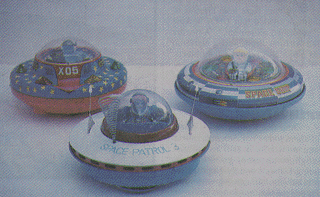

Tin-Litho
Invaders
The golden era of Japanese space toys - the 50s and 60s, more or less - coincided neatly with the peak of America's saucer mania. Even if they were never quite as popular as the more conventional rockets, robots and spacemen, dozens of fascinating and colorful tin-toy flying saucers still landed in our midst, all of them rather endearingly goofy. To single out but a few:
Japan's Masudaya Company ("for the children of the world!") produced a series of bubble-topped, bump-and-go saucers about eight inches wide, featuring flashing lights and spooky whirring noises powered by two D cells. The Space Ship X-5 of the latter 1960s is piloted, oddly, by an astronaut - as is the all but identical X-7. The UFO X-05 of the same period has a robotic-looking alien pilot at the helm. Another 1960s-era Masudaya saucer, a squatty-looking affair called the Satellite X-107, vaguely resembles a green bowler hat, and launches a spinning plastic "satellite" from its crown (assuming you are lucky enough to find an intact specimen). Yoshiya's Space Patrol of the early 1960s, also roughly eight inches in diameter, was one of the era's most attractive toy saucers. Manufactured in red and white-and-blue-bodied versions, both feature jaunty swept-back aerials that suggest automotive tail fins, giving the craft a charmingly retro look. When the saucer is activated, the Space Patrol pilot ratchets his arms violently back and forth over the controls with an alarming grinding noise that makes you turn it off immediately if you've paid a collector's price for it (I suspect these toys were short-lived in normal use).
Suffice it to say that there were many others, ranging from a variety of little friction-operated UFOs about three inches wide, to Cragstan's 10-inch Space Ship saucer of 1958, to Masudaya's impressive Space Giant, a gorgeous red-and-silver saucer (featuring an ineffective-looking rudder) measuring more than a foot across.
And just what should you expect to part with for these shiny wonders? That's a thorny question, although the answer is definitely not "a pittance." As most wide-awake collectors probably know, prices for vintage Japanese space toys in general checked into Hotel Lunacy quite some time ago. Until recently, however, the best flying saucers have remained relatively reasonable compared to the white-hot world of serious robot collecting, where four-figure prices are increasingly the norm. I'm not sure that will remain the case.
About five years ago, for instance, I picked up a
fine-condition Yoshiya Space Patrol saucer, no box, for
about $100, a price that struck me as fair. In early
1994, I encountered an enterprising pirate at a
collector's show who was asking $950 for the same saucer,
admittedly a mint specimen. The "going rate,"
or a Prozac moment on the dealer's part? You tell me.
-Bruce Lanier Wright
MAIN ARTICLE: INVADERS FROM ELSEWHERE
SIDEBARS
Photos by Bruce Lanier Wright
Strange Magazine contributing editor Bruce Lanier Wright is a pop-culture historian and avid, if puzzled, fortean living in Austin, Texas.
